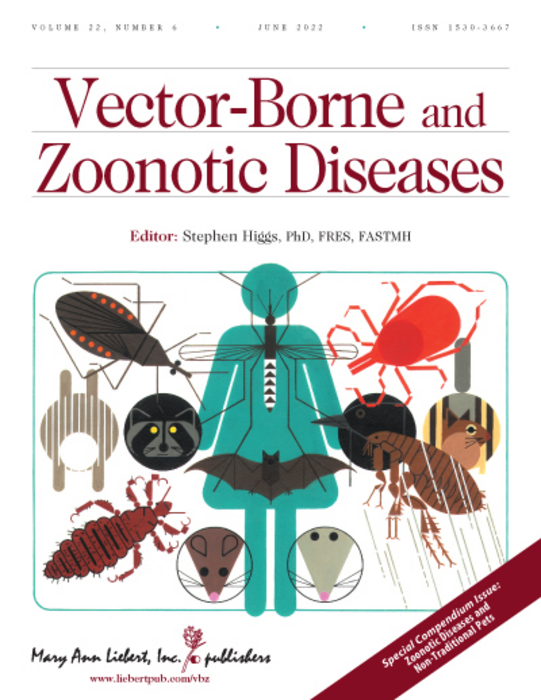Contact with non-traditional pets increases the risk of exposure to zoonotic pathogens, which are pathogens that spread between animals and people. The National Association of State Public Health Veterinarians, together with the Centers for Disease Control and Prevention, examine the threat to pet owners and provide recommendations for prevention in an article published in the peer-reviewed journal Vector-Borne and Zoonotic Diseases. Click here to read the article now.

Credit: Mary Ann Liebert Inc., publishers
Contact with non-traditional pets increases the risk of exposure to zoonotic pathogens, which are pathogens that spread between animals and people. The National Association of State Public Health Veterinarians, together with the Centers for Disease Control and Prevention, examine the threat to pet owners and provide recommendations for prevention in an article published in the peer-reviewed journal Vector-Borne and Zoonotic Diseases. Click here to read the article now.
“Guidance on preventing zoonotic diseases, caused by pathogens that spread between animals and people is urgently needed,” state Kate Varela, DVM, MPH, from the Centers for Disease Control and Prevention, writing on behalf of the National Association of State Public Health Veterinarians in collaboration with and reviewed by the Centers for Disease Control and Prevention.
The data show that three major group of animals have been associated with outbreaks of zoonotic diseases in people in the U.S,: rodents, backyard poultry, and reptiles. This compendium presents information on these and other non-traditional pet animal species associated with a high risk of zoonotic disease transmission. Other animal species covered in the compendium include non-rodent mammals, such as hedgehogs and ferrets, amphibians, and other aquatic species.
Pets can appear healthy while carrying zoonotic pathogens, putting pet owners and others at risk. In fact, most of the pathogens described in the compendium do not cause illness in the animal host. Zoonotic pathogens can be transmitted by direct or indirect animal contact.
The compendium lists common risk factors that lead to illness associated with non-traditional pet species. It provides a summary of identified outbreaks, case reports, and types of pathogens in the U.S from 1996 through 2017. The compendium provides a comprehensive review of zoonotic pathogens among non-traditional pets. It provides recommendations for preventing transmission of zoonotic pathogens.
“This dedicated issue of Vector-Borne and Zoonotic Diseases, published at a time of heightened public awareness of monkeypox, provides information on zoonotic pathogens associated with many species of non-traditional pets, and is a global resource for the pet industry, pet owners, veterinarians, physicians, researchers and many others,” says Stephen Higgs, PhD, Editor-in-Chief of Vector-Borne and Zoonotic Diseases and Director, Biosecurity Research Institute, Kansas State University, Manhattan, KS.
About the Journal
Vector-Borne and Zoonotic Diseases is an authoritative peer-reviewed journal published monthly online with open access options and in print dedicated to diseases transmitted to humans by insects or animals. Led by says Stephen Higgs, Ph.D., Director, Biosecurity Research Institute, Kansas State University, Manhattan, KS, the Journal covers a widespread group of vector and zoonotic-borne diseases including bacterial, chlamydial, rickettsial, viral, and parasitic zoonoses and provides a unique platform for basic and applied disease research. The Journal also examines geographic, seasonal, and other risk factors that influence the transmission, diagnosis, management, and prevention of zoonotic diseases that pose a threat to public health worldwide. Vector-Borne and Zoonotic Diseases is the official journal of SocZEE, the Society for Zoonotic Ecology and Epidemiology. Complete tables of content and a sample issue may be viewed on the Vector-Borne and Zoonotic Diseases website.
About the Publisher
Mary Ann Liebert, Inc., publishers is known for establishing authoritative peer-reviewed journals in many promising areas of science and biomedical research. Its biotechnology trade magazine, GEN (Genetic Engineering & Biotechnology News), was the first in its field and is today the industry’s most widely read publication worldwide. A complete list of the firm’s more than 100 journals, books, and newsmagazines is available on the Mary Ann Liebert, Inc., publishers website.
Journal
Vector-Borne and Zoonotic Diseases
DOI
10.1089/vbz.2022.0022
Method of Research
Experimental study
Subject of Research
People




